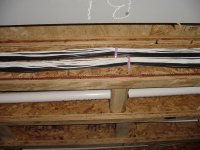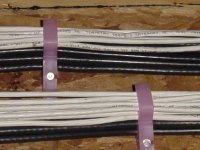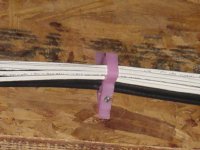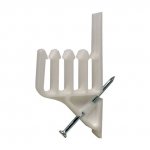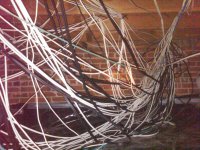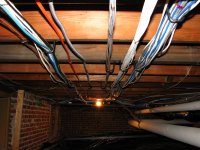Interesting I did not know that.Interesting to note that it's one of the reasons that the Code limits the length of OSP cables in buildings. The flooding compound is flammable and underground cable is required to go directly to a terminal in the building that has a steel compartment with a cover for the pairs to be punched down.
You are using an out of date browser. It may not display this or other websites correctly.
You should upgrade or use an alternative browser.
You should upgrade or use an alternative browser.
Coaxial cable
- Thread starter nizak
- Start date
- Status
- Not open for further replies.
LarryFine
Master Electrician Electric Contractor Richmond VA
- Location
- Henrico County, VA
- Occupation
- Electrical Contractor
hbiss
EC, New York NEC: 2017
- Location
- Little Falls, New York NEC: 2017
- Occupation
- EC
What are those Larry? Did you make them? For that number of cables, I have always used Caddy J hooks.
https://www.nvent.com/en-us/caddy/products/nvent-caddy-cat-hp-j-hook-0
-Hal
https://www.nvent.com/en-us/caddy/products/nvent-caddy-cat-hp-j-hook-0
-Hal
hbiss
EC, New York NEC: 2017
- Location
- Little Falls, New York NEC: 2017
- Occupation
- EC
Incidentally, while IT weanies and BICSI insist on using nothing other than Velcro straps to bundle cables because they are soft and gentle, I have no problem with Ty-Raps as long as you keep them loose enough to not deform the cables.
-Hal
-Hal
LarryFine
Master Electrician Electric Contractor Richmond VA
- Location
- Henrico County, VA
- Occupation
- Electrical Contractor
25yrApprentice
Member
- Location
- Denver, Colorado
- Occupation
- Specialty Electrical Contractor
Wow Hal, getting spicy with the new guy huh?! I'll have you know I was pulling cable since you were in diapers. The adult kindHaven't seen any, except for some things you said.
Should we ask Ron Tellas over at Belden what he thinks about that statement? I thought this forum was for professionals, not home owners and hacks!Staples? That's not true, they are fine. But yes, anything that deforms the cable will cause problems. Preferably use insulated staples (because the plastic won't damage the cable) and don't sock them down. Stay away from staple guns, but sometimes you can't when you are doing exposed work. At least use the proper size staple and don't sock them down either. You should be able to slide the cable through the staple to show that it hasn't been compressed.
The truth is, the only time it is acceptable to use electrical staples on coax or category cable is when you only have one box of cable on your truck and you're in a crawl space and you need to run a few drops to the same place so you lightly tack up a few staples to help route the wires. I'm ok with it as long as you go back and remove the staples as you screw clip those wires tight and neatly in place. But seriously, if you think it's ok to tell an apprentice to take a hammer and hang up this data cable in my client's home or business, I don't want you on my job.
I'm also ok with staples (with plastic inserts) on speaker wires, sprinkler cable, security wire and thermostat wire. In other words, "staples are for dummies" lol. Get it? Wires that don't communicate? Dummies? Yeah, stupid joke, sorry.
I'm pretty sure that's what I said. Let me look... Yup, that's what I said.Rule is that copper clad steel is economical for anything that isn't carrying power. For SAT dishes, etc. where the cable carries power also, always use a cable with a solid copper center conductor.
If you're going to correct me Hal, at least be right. You are getting confused between "underground" cable and "direct burial" cable. To be clear, I said "Direct Burial".The jacket on direct burial cable is polyethylene (like sprinkler pipe) as opposed to PVC. Direct burial cable is filled with a flooding compound, variations look like grease, goo, etc. The flooding compound keeps any water that might enter through a nick or cut in the jacket from entering the cable or, if it does, from migrating along under the jacket. No, it does not coagulate.
"Underground" cable jacketing is made from either PE for it's temperature resistance, or CPE (chlorinated polyethylene), for better water intrusion characteristics, but you are correct that it does need to be in conduit because it is also not "waterproof enough" or crush resistant. It does have a polymer gel flooding compound that resembles "goo" and you are correct that it is flammable and not to be run through a firewall outside of metal conduit and metal termination boxes.
"Direct Burial" cable jacketing is made from a thicker and chemically crosslinked CPE that is designed to be DIRECTLY BURIED in the ground with no conduit necessary, because the jacket must meet the same standards of crush rating, temperature resistance and water intrusion as a conduit would. It is filled with a *what? OMG* formulated powder tape that... wait for it... COAGULATES! when exposed to water to stop water intrusion from spreading. And you're going to love this last part Hal. It also carries a PLTC rating for flame resistance, so it can be run directly from outside to inside locations at any length up to 330' or 100m as per the usual, because of this specially formulated coagulating powder coated tape vs the flammable "goo".
Source: Used to work for Belden's largest distributor CSC and got to go to their manufacturing plant for a week long training on cable manufacturing. Super cool company.
-your new favorite IT weenie
PS Seriously, I hope we can be friends. My New Jersey self righteous attitude loves that New York I'm better than you arrogance.
Last edited by a moderator:
- Location
- Tennessee NEC:2017
- Occupation
- Semi-Retired Electrician
Keep the language, attitude, and arrogance out of this or this thread will disappear!
25yrApprentice
Member
- Location
- Denver, Colorado
- Occupation
- Specialty Electrical Contractor
25yrApprentice
Member
- Location
- Denver, Colorado
- Occupation
- Specialty Electrical Contractor
Roger Roger. Apologies. UnderstoodKeep the language, attitude, and arrogance out of this or this thread will disappear!
zbang
Senior Member
- Location
- Roughly 5346 miles from Earls Court
You don't need to defend your honor, you need to defend your answers.
All the blather about which RG is better is pretty much useless expect for overall size and impedance, give us a proper description or a mfg number. Baseband video? Belden 8281 was the bees knees (and IIRC "RG11") but was surpassed by 1694a (and 8241 worked fairly well, too). Want to run a DS3 signal? AT&T 743a is the usual ticket and could count as RG6. How about HD-SDI video? 8281 will do but 1505 (RG59 type) or 1694 (RG6 type) are common. Pick your acceptable loss/jacket material/size and run with it.1. RG59 has higher loss over long runs, ...
2. RG59 with copper braid is used for analog surveillance cameras.
3. Quad shield has mid level loss compared to standard dual shield RG6...
4. Only cheap chinese RG6 and RG59 copper braid has no foil. ...
Citation please, the shielding should prevent external metal from affecting the signal. That said, don't hammer down the staple and crush the dielectric; that's a separate thing from the material. (It's interesting to see the signature of a crimp/crush on a TDR trace, spent a lot of time looking for those in the 90s.)5. Don't use metal staples on coax (or cat5/6 for that matter). It causes frequency trapping. Use coax screw clips. Pinching the dielectric foam changes the frequency response.
Why not? unless you're using the wrong crimper with the the wrong connector which is destined to fail (connector and crimper should always match, especially when there are minute differences in jacket diameter).8. Never use hex crimped F connectors.
hbiss
EC, New York NEC: 2017
- Location
- Little Falls, New York NEC: 2017
- Occupation
- EC
If you were in sales, we might have talked. Didn't usually use a lot of Belden however. Best cable around but the price will kill you. Used to use a lot of West Penn for my audio jobs. A little less money.Used to work for Belden's largest distributor CSC
-Hal
zbang
Senior Member
- Location
- Roughly 5346 miles from Earls Court
Yep, when I was doing PA/FA/burglar in the mid-atlantic, it was always West Penn unless the bid docs said otherwise. When I started going video work, the A & V were usually Belden, Canare, or occasionally CommScope, but control lines were still often WP.
gadfly56
Senior Member
- Location
- New Jersey
- Occupation
- Professional Engineer, Fire & Life Safety
Uh oh, is that MC running on the bottom of the joist, next to the red cable? About the 4th hanger set from the left.Super clean! Not that you need my approval, but I approve
Here's a little before and after on a job I took over.
View attachment 2571755View attachment 2571756
waxerk5
Member
- Location
- California
- Occupation
- Contractor C7 & C10
What is the usage for? By performance difference, are you referring to the loss?Is there any performance difference between RG6 and RG6 Quad Shield?
Does the box store cable perform as well as what would be provided by say Charter for example.
It all appears to be 18 gauge.
Thanks
hbiss
EC, New York NEC: 2017
- Location
- Little Falls, New York NEC: 2017
- Occupation
- EC
Depends on the environment as talked about above.Is there any performance difference between RG6 and RG6 Quad Shield?
Does the box store cable perform as well as what would be provided by say Charter for example.
Dunno. What is the Big Box cable and how do the specs compare to whatever Charter uses? Loss vs frequency, shielding, etc. Then of course, like anything else today, is the Big Box stuff cheap Chinese junk or made by a reputable company.
It all appears to be 18 gauge.
Nothing to do with anything except the 75 ohm cable impedance of an RG6 type cable.
-Hal
Is coax required to be UL listed in the NEC?4. Only cheap chinese RG6 and RG59 copper braid has no foil. UL listed RG6 used in cable plant transmission and satellite tv etc is dual shield, has a layer of foil on the outside of the dielectric, followed by a certain percentage of aluminum braid (good stuff is typically 70%, but only american brands like belden actually meet their own spec).
Any questions?
I am not even sure what the stuff we pull in new homes is, but I have never seen a listing mark on the boxes.
Sometimes the stuff we rope in is a coax with a cat-something all in one cable, or like two of each (4 cables).
hbiss
EC, New York NEC: 2017
- Location
- Little Falls, New York NEC: 2017
- Occupation
- EC
Yes. Just like any other CL2 or CM cable it comes in general, riser and plenum. Within a building, you must use a cable that has the proper listing printed on the jacket to be code compliant. For some reason not all cable will have the listing printed on it even though it is on the label on the reel or box. Naturally, the cheap Chinese stuff will never have it. I always had to make an issue of it with the supplier that I had to have cable with the listings printed on it.Is coax required to be UL listed in the NEC?
-Hal
- Status
- Not open for further replies.

